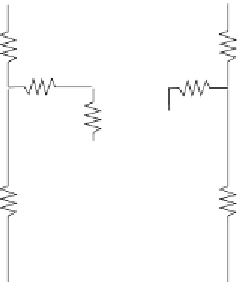Geoscience Reference
In-Depth Information
q
T
T
E
E
H
H
r
r
q
sat
(
T
S
)
r
r
q
T
T
r
q
sat
(
T
S
)
r
r
E
H
q
g
θ
g
T
g
Figure 9.15
LSM with a single vegetation layer and multiple soil layers. The air
temperature and humidity at the canopy level (
T
ac
and
q
ac
) are coupled to the air
above through the aerodynamic resistance
r
a
, to the vegetation (through boundary-
layer resistance
r
b
and canopy resistance
r
c
) and to the soil temperature and humidity
(
T
g
and
q
g
) through the in-canopy aerodynamic resistance
r
ac
. The liquid water reser-
voir (rainfall interception or dew) is directly coupled (through
r
b
) to the canopy air,
as there is no stomatal control.
LSMs with Empirical Stomatal Control (Second Generation)
Deardorff (1978) was the irst to develop a LSM that incorporated vegetation, which
has been further developed by many others into models of varying complexity (see,
e.g., Pitman,
2003
, for an overview).
In these LSMs the vegetation consists of one (or more) layer that covers a fraction
σ
f
of the ground, thus exposing a fraction 1−
σ
f
of bare soil.
Figure 9.15
provides a
sketch of the way evapotranspiration and sensible heat lux are parameterized for
a single-layer model. To allow for separate luxes from the soil and the vegetation
layer, an extra atmospheric layer is introduced: the canopy air. Both the soil surface,
the vegetation layer and the atmosphere above, exchange heat and water vapour with
this layer.
An essential property of the vegetation layer in these models is that the transpiration
from the plants is regulated by a canopy resistance, which depends on environmental
conditions such as solar radiation and temperature, as well as on soil moisture content
(see
Section 9.2.4
). The water needed for the transpiration lux is extracted from one
or more soil layers depending on the vertical distribution of the roots. The latter in
turn depends on the type of vegetation to be modelled. The surface of the vegetation




























































Search WWH ::

Custom Search